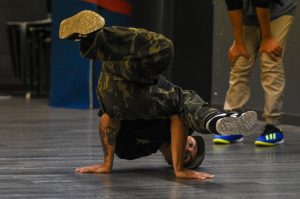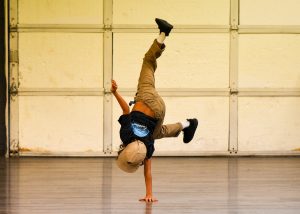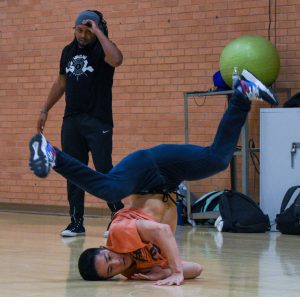- Slug: Sports-Breakdancing Popularity Olympics. 1,800 words
- 3 photo, captions below.
- Video clip available.
By Brady Vernon
Cronkite News
MESA – Speakers sit in each corner, resting atop a wooden floor covered in nicks and dings from years past. Conrad Rodriguez uses his left hand to push himself into the air, his perfect landing defined by a spin on his head.
The room isn’t just another cluttered space, it’s a canvas for a dancer’s art. On this day the artist is a 25-year-old showcasing the impossible.
Rodriguez is a “b-boy.” Commonly known as breakdancers, they prefer to be called “breakers.” And it isn’t just a hobby for Rodriguez. He’s trying to book a 2024 ticket to Paris where he hopes to battle for an Olympic medal.
Breaking is under consideration for the Paris 2024 Summer Olympics with a final decision expected in December of 2020. The hip-hop dance style debuted in Bueno Aires as a medal event in the 2018 Summer Youth Olympics. And the International Olympic Committee has formally endorsed a request from Paris organizers to add the sport.
One no longer has to go to neighborhoods in the Bronx to find breakers. They can be found throughout Arizona. In hallways and empty classrooms that go unnoticed on university campuses. In dances studios of strip malls near highway exits. Once considered a fad, the shoes that replaced paint brushes for street art in the 1970s are potentially stepping onto the podium of the world’s biggest competition.
It’s a culture.
“It’s a vibe, it’s so good,” Rodriguez said. “A bunch of diversity, you have color everywhere. Most jams have really good music, you got dope ‘b-boys,’ ‘b-girls,’ DJs. I’ve met people who don’t even speak English and we’re just talking through ‘boom, boom, bhap, bhap, bhap, yeah, yeah, like that.’ That’s how we communicate.”
The beginnings
Breaking is widely believed to have started in the Bronx in the 1970s, one way for disadvantaged youth to be recognized. In the early days of deejaying, popular ones like DJ Kool Herc, who helped originate hip hop music in the 1970s, would isolate the instrumental portion of the music to highlight the percussion.
Those “breaks” in the music would then be looped together and became longer, said James Mansour, a director at Mesa’s The Jukebox Dance Studio. The breakers would dance during those interludes and the performances evolved.
It soon became a cultural expression and even a way for rival gangs to compete.
Breaking hit its peak in the public’s eye in the 1980s with appearances in movies including “Flashdance” and “Breakin’ 2: Electric Boogaloo.”
It made a resurgence in the 2000s thanks in part to talent show-like television, including “So You Think You Can Dance” and “America’s Best Dance Crew.” There was even a Volkswagen Golf car commercial in 2005 that featured iconic performer Gene Kelly rapping and breakdancing to a club mix of “Singin’ in the Rain.”
Four basic elements define breaking: top rock, the footwork that usually starts the set; down rock, the dropping down to the floor that helps with transitions; freeze, the act of stopping on a specific beat and returning to a transition; and power moves, acrobatic elements such as head spins.
With the growth of social media and video platforms, breaking’s audience has expanded. Rodriguez teaches a class at Jukebox filled with many students under the age of 10, as well as the originals from a Bronx established crew, Rock Steady, with performers in their 50s that feature nicknames like “Crazy Legs.”
A transition
Mansour, who is a generation older than Rodriguez, said he was always told breaking was just a fad. Now he’s watching an activity that once had police chasing people off the streets transform into an Olympic event.
Like many, Mansour wonders about judging.
“I’m just curious to see the rules, scoring systems they’re figuring out,” he said. “Who is all going to be involved figuring out these rules. Hopefully, they go with people who have been doing it and know the culture.”
Mansour believes the publicity will provide a gateway for people to start making a living from breaking. Even with the physical demands the sport requires, professional breakers aren’t paid enough to live comfortably, Rodriguez said.
First, however, he and others hope to clarify for a broader audience the proper name for what they do.
Originally coined “breakin” due to b-boys and b-girls beginning their dance at the break part of the music, it soon became “breakdancing” because it was easier to communicate in the media.
Once the International Olympic Committee made the announcement that “breakdancing” could be added to the 2024 Games, hundreds of his friends took to Facebook, Rodriguez said. Many, including himself, starting sharing a petition to get “breakdancing” changed to its correct form of “breaking.”
Many breakers aren’t offended by the use of “breakdancing,” said Arian “Shadoe” Tontowl, a fellow instructor at Jukebox and part of the Rock Steady Crew, except when a breaker uses it in conversation with another breaker.
“With anything that’s new, everybody is like ‘change, no, no,’” Mansour said. “It is what it is. Even us use the term because we want to make sure people understand it.”
Going corporate
Part of breaking’s more recent breakout involves show sponsorships from companies including Red Bull and Monster, along with shows and movies such as the “Step Up” franchise. When Tontowl started dancing at 15, his interest was sparked by Red Bull BC One, an annual international breaking competition organized by the energy drink company.
Outside of viewing Red Bull BC One, Tontowl’s start began at school, when a classmate asked Tontowl if he was a breaker after watching him do a handstand in a weight-training class. When he said no, the classmate brought him to the house of a cousin, who was into breakdancing, and Tontowl was hooked.
Rodriguez’s journey started at family parties after seeing his uncles do it. He later went to various clubs in Mesa to start his breaking career.
Each b-boy and b-girl has a unique story about how they were introduced.
Zakiyyah Merritt’s started during her sophomore year at Arizona State, when she noticed the Sun Devil Breakdancing Club was practicing outside Hayden Library and she peaked over a wall to watch. After a few emails to one of the club’s creators, Julian Szablowski, Merritt watched the club practice. Now she’s part of the group.
Merritt has friendships she’d never imagined, including with fellow SDBC members Susan Hong and Lysette Gonzales. One trip to San Diego with the club for a college crew battle event stands out.
“For me and Zakiyyah, it was super cool for us to have gone and actually have battled,” Hong said. “There was such little b-girl representation there, there was only three of us. It was fun because we weren’t just in the back, we weren’t just thrown in when we had to. We jumped in, we were super active as representatives of our crew.”
Bonding experience
Many of the breakers used the word “unity” to describe how dancing has brought them together. Especially for Tontowl, who was born in Indonesia and moved to the United States when he was 12.
“It reminded me of my home country,” he said. “We can all speak the same language, which is through dance. I’m able to express myself freely. The universal language from it helps me meet other people from a different country or different religion.”
Tontowl, 29, has no intention of training for the Olympics, but it doesn’t mean he has lost his love for breaking. It led him to engineering because he wants to open up a community center for breaking in Indonesia.
“Now, I have a different role within the breaking community in Arizona,” Tontowl said. “I’m passing the torch to the next generation. I don’t try to battle, I don’t try to make it to the Olympics.”
Breakers’ highlights are just as impressive as those of other major athletes in Mansour’s opinion.
“They’re doing superhuman things.”
Despite its birth in the United States, there was no U.S. representation in the Youth Olympics in 2018. With the help of YouTube, Mansour said, kids from Asia, Europe and South American are doing things that 40 years ago people would never have fathomed.
“Breaking takes a lot of physical movements from martial arts, different street-dance styles, jazz, disco,” he said. “You’re taking a wide variety of things and putting it all into this one art form that puts your physical limits, constantly testing your limits, wanting to do something more.”
Providing an identity
Despite Lysette Gonzales’ stature, breaking allows her to feel a way she has never felt before, she said.
“Breaking is a way to push myself and test my limits of what I can do physically,” she said. “I’m small, I’m a girl, if I can do what the big guys can do and I’m sick. That’s what pushes me.”
Hong agrees.
“You have to push your physical body to go past limits that no other human being can do,” Hong said. “You’re literally doing things that are defying gravity.”
As in any sport, injuries happen. Rodriguez has suffered sprained wrists and ankles, had a concussion and pulled his groin. He is not invincible, although when breaking for a mere 45 seconds, he sure feels like it, he said.
“It’s like you’re going on the ride, it’s magic, it’s lovely,” he said smiling. “It’s freeing, it feels really good. It’s hard to describe, it just feels so good to my soul. I love it.”
How is it that a barista with a passion for dancing has a chance to become an Olympic athlete?
He knows ideally he should be training full time. But he can’t make a living off of it yet and is OK with make coffee while putting in 25-30 hours a week breaking.
Rodriguez never thought he’d be in the position he is today. Much like how he copied his uncles, he kept watching more and more on YouTube for different tricks and moves.
Eventually, he joined different crews as he grew up, learning various moves and positions from friends and foes. As time went on, Rodriguez wanted to learn more. A friend in 2009 brought him to his first jam and from the moment the door opened, he was sold. The DJs, MCs, graffiti, the checkered floors, the b-boys, the battles. He wanted to excel at it.
He competed in his first competition a few years later in an event put on through Arizona State. But the competitive aspect is only part of the reason he does it. The culture, the atmosphere of the events keep the fire burning.
With such international popularity, the Olympics seem well-suited for breaking. Rodriguez agrees, but has no expectations for what the future holds in Paris or even in Los Angeles in 2028. He doesn’t want to be let down if it’s not what he expects.
To him, it started as fun and he wants it to stay that way. Rodriguez may one day represent the United States breaking team, with a gold medal placed around his neck. He’s not worried about that just yet.
He’s going along with the flow, because that’s what the best breakers do.
Follow us on Instagram.
For more stories from Cronkite News, visit cronkitenews.azpbs.org.


